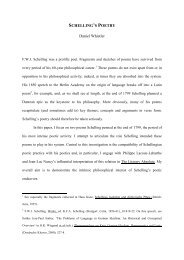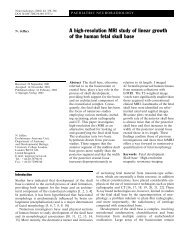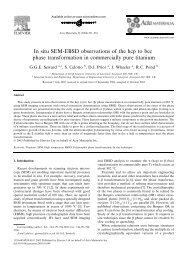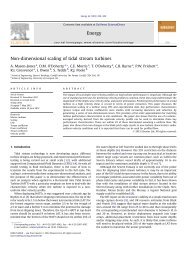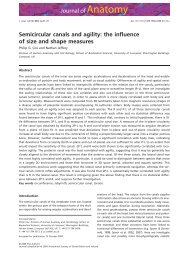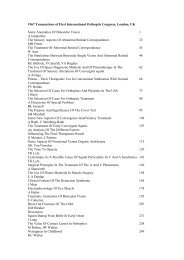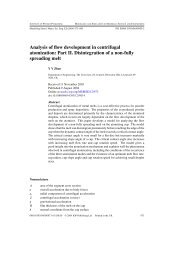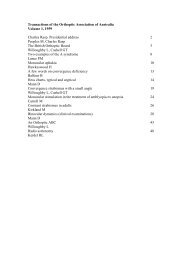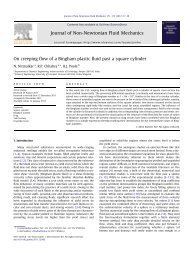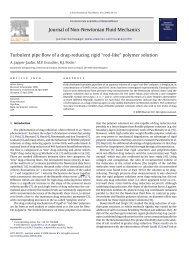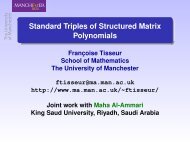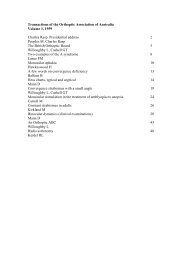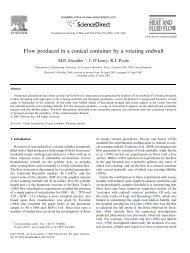Beyond the Pre-Pottery Neolithic B interaction sphere - University of ...
Beyond the Pre-Pottery Neolithic B interaction sphere - University of ...
Beyond the Pre-Pottery Neolithic B interaction sphere - University of ...
Create successful ePaper yourself
Turn your PDF publications into a flip-book with our unique Google optimized e-Paper software.
98 J World <strong>Pre</strong>hist (2006) 20:87–126<br />
critique <strong>of</strong> <strong>the</strong> Lyon School culture-historical approach and its long-term impact on Near<br />
Eastern prehistoric research, see Delage, 2004).<br />
Social approaches and PPN diffusion<br />
A number <strong>of</strong> comparatively recent studies in <strong>the</strong> <strong>Neolithic</strong> <strong>of</strong> Western Asia have concentrated<br />
on <strong>the</strong> identification and analysis <strong>of</strong> <strong>the</strong> social practices that structured <strong>the</strong> daily<br />
life and collective organization <strong>of</strong> Early <strong>Neolithic</strong> communities (Kuijt 1996, 2000a, b, c,<br />
2002). Social approaches have a long and distinguished history in <strong>the</strong> <strong>Neolithic</strong> archaeology<br />
<strong>of</strong> <strong>the</strong> region, concentrating on diverse issues such as household structure and<br />
organization, social differentiation, competition and <strong>the</strong> negotiation <strong>of</strong> power (Flannery,<br />
1972; Bender, 1978; Banning & Byrd, 1987, 1989; Hodder, 1990; Byrd, 1994; Hayden,<br />
1995). Perhaps <strong>the</strong>ir most important contribution has been <strong>the</strong> breaking down <strong>of</strong> <strong>the</strong><br />
artificial distinctions between site assemblages created by <strong>the</strong> culture-historical and<br />
regionalist schools <strong>of</strong> thought. This <strong>the</strong>y do by focusing on <strong>the</strong> analysis <strong>of</strong> social processes,<br />
with an emphasis on human agency, which can be investigated through <strong>the</strong> comparative<br />
analysis <strong>of</strong> individual sites and groups <strong>of</strong> sites. Their main foci <strong>of</strong> analysis include ritual<br />
expression, household and kinship structure, kinship ideologies and practices in relation to<br />
subsistence and craft production, territoriality, group identity and social differentiation.<br />
A trend in favour <strong>of</strong> anthropologically informed explanations is also latent in polycentric<br />
models (e.g. Gebel, 2002, 2004). However, polycentric models have proved more<br />
suitable for describing ra<strong>the</strong>r than explaining diversity. Several comparative studies <strong>of</strong><br />
regional site assemblages based on social approaches have shown, for example, that<br />
important components <strong>of</strong> Early <strong>Neolithic</strong> lifestyles transcend archaeologically defined<br />
regional ‘‘cultures’’ and <strong>the</strong>ir formal chronostratigraphic facies. The recognition <strong>of</strong> this<br />
reality has in turn helped to define a number <strong>of</strong> core <strong>Neolithic</strong> social strategies that may lie<br />
behind similarities in material culture and symbolic expression, and which manifested in<br />
versatile ways across different geographical and cultural contexts (see contributions in<br />
Kuijt (2000a); o<strong>the</strong>r examples <strong>of</strong> similarly oriented <strong>the</strong>oretical and pragmatic, evidencebased<br />
approaches can be found in Rosenberg (1998), Wright (2000), Verhoeven (2002a, b,<br />
2004), Hardy-Smith and Edwards (2004)).<br />
Issues relating to <strong>the</strong> scale and scope <strong>of</strong> Early <strong>Neolithic</strong> social organization are particularly<br />
pertinent in exploring <strong>the</strong> likely causal factors <strong>of</strong> population dispersals. Settlement<br />
diffusion likely was a versatile process whose rate and geographical direction might have<br />
been controlled, at least in part, by processes <strong>of</strong> group fission in <strong>the</strong> (equally diverse) parent<br />
communities <strong>the</strong>mselves. In turn, <strong>the</strong> causes <strong>of</strong> such phenomena could have more to do<br />
with emergent inter-societal tensions ra<strong>the</strong>r than a downright ‘‘expansionist ethos’’. In <strong>the</strong><br />
case <strong>of</strong> <strong>the</strong> sou<strong>the</strong>rn Levant, for example, it has been suggested that <strong>the</strong> social challenges <strong>of</strong><br />
sedentism and attendant demographic shifts figured prominently among <strong>the</strong> concerns <strong>of</strong> <strong>the</strong><br />
Early <strong>Neolithic</strong> communities, manifested in <strong>the</strong> domains <strong>of</strong> settlement organization and<br />
ritual expression (for general overviews, see Kuijt, 1996, 2000a; Kuijt & Goring-Morris,<br />
2002). It is conceivable that such societal developments might not have represented a oneway<br />
road to success for every household and/or kin group. Despite <strong>the</strong> apparent status <strong>of</strong><br />
mortuary rituals as socially sanctioned means for limiting nascent social inequalities, at <strong>the</strong><br />
same time <strong>the</strong>y fostered a measure <strong>of</strong> social differentiation (through <strong>the</strong> differential<br />
treatment <strong>of</strong> particular individuals and <strong>the</strong> codification <strong>of</strong> funerary tasks performed<br />
by ritual specialists) that prepared <strong>the</strong> ground for <strong>the</strong> emergence <strong>of</strong> ritual, civic and economic<br />
‘‘elites’’ (Kuijt, 1996, 2000b, c, 2002; Goring-Morris, 2000). Thus <strong>the</strong>y effectively<br />
123



